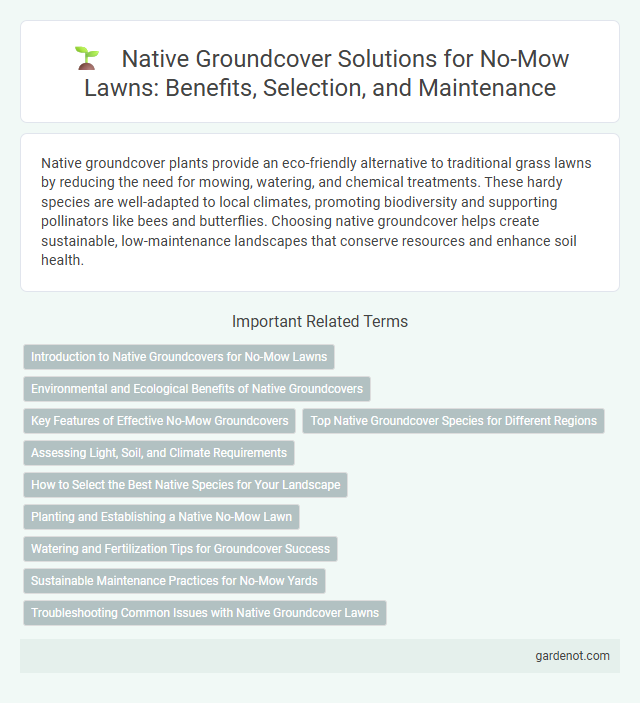Native groundcover plants provide an eco-friendly alternative to traditional grass lawns by reducing the need for mowing, watering, and chemical treatments. These hardy species are well-adapted to local climates, promoting biodiversity and supporting pollinators like bees and butterflies. Choosing native groundcover helps create sustainable, low-maintenance landscapes that conserve resources and enhance soil health.
Introduction to Native Groundcovers for No-Mow Lawns
Native groundcovers are low-maintenance plants that thrive in local climates, making them ideal for no-mow lawns. These species, such as creeping thyme, white clover, and bearberry, provide dense, attractive greenery without the need for regular mowing. Incorporating native groundcovers enhances soil health, reduces water usage, and supports local biodiversity.
Environmental and Ecological Benefits of Native Groundcovers
Native groundcovers significantly enhance soil health by reducing erosion and improving moisture retention through their deep root systems. They support local biodiversity by providing habitat and food for native pollinators, insects, and wildlife, thereby promoting ecological balance. These plants require minimal maintenance, such as reduced watering and no fertilizers, contributing to lower environmental impact and sustainable landscaping.
Key Features of Effective No-Mow Groundcovers
Native groundcovers in no-mow lawns offer drought tolerance, pest resistance, and adaptability to local soil conditions, reducing maintenance needs. Species like Creeping Thyme, Bearberry, and Sweet Woodruff create dense mats that suppress weeds and improve soil health through natural nitrogen fixation. Their low growth habit minimizes mowing frequency, enhances biodiversity, and supports pollinator habitats effectively.
Top Native Groundcover Species for Different Regions
Top native groundcover species vary by region, ensuring ecological harmony and low maintenance for no-mow lawns. In the Pacific Northwest, Oregon grape (Mahonia aquifolium) and Salal (Gaultheria shallon) thrive with excellent soil coverage and drought resistance. The Southeast favors Creeping Phlox (Phlox stolonifera) and Wild Ginger (Asarum canadense) for their dense growth and shade tolerance, while the Midwest region benefits from Prairie Dropseed (Sporobolus heterolepis) and Wild Strawberry (Fragaria virginiana) in no-mow landscapes.
Assessing Light, Soil, and Climate Requirements
Native groundcovers thrive best when their light, soil, and climate needs are well matched to the local environment. Assessing sunlight exposure helps determine whether species require full sun, partial shade, or full shade to optimize growth and sustainability. Soil type, pH balance, moisture levels, and temperature tolerance also critically influence the success of no-mow lawns using native plants, reducing maintenance and enhancing ecological benefits.
How to Select the Best Native Species for Your Landscape
Selecting the best native groundcover species for your no-mow lawn involves evaluating local climate, soil type, and sunlight exposure to ensure adaptability and thriving growth. Prioritize species such as creeping thyme, bearberry, or sedum that are drought-tolerant and require minimal maintenance. Native plants enhance biodiversity, reduce water usage, and promote a healthy ecosystem in your landscape.
Planting and Establishing a Native No-Mow Lawn
Selecting drought-tolerant native groundcover species such as Creeping Thyme, Blue Star Creeper, and Bearberry ensures a resilient no-mow lawn that conserves water and supports local biodiversity. Preparing the soil by removing existing grass and aerating promotes strong root development, while planting in early spring or fall maximizes establishment success. Regular watering during the initial growth period and minimal disturbance thereafter help native plants form a dense, low-maintenance cover ideal for sustainable landscaping.
Watering and Fertilization Tips for Groundcover Success
Native groundcovers thrive with minimal watering once established, relying on deep, infrequent irrigation to promote drought resistance and healthy root growth. Fertilization should be applied sparingly, using slow-release, low-nitrogen fertilizers to encourage steady growth without excessive foliage that invites pests. Proper watering and tailored fertilization ensure vibrant, resilient native groundcovers, reducing maintenance and supporting sustainable no-mow lawn landscapes.
Sustainable Maintenance Practices for No-Mow Yards
Native groundcovers such as creeping thyme, bearberry, and sedum provide sustainable alternatives for no-mow yards by reducing water usage and eliminating the need for chemical fertilizers or herbicides. These low-growing plants promote biodiversity by supporting pollinators and enhancing soil health through natural nutrient cycling. Maintenance practices focus on minimal irrigation, periodic pruning to prevent overgrowth, and monitoring for invasive species to ensure long-term ecological balance.
Troubleshooting Common Issues with Native Groundcover Lawns
Native groundcover lawns may face common issues such as patchy growth, weed invasion, and slow establishment. Address these problems by ensuring proper soil preparation, selecting species adapted to local climate conditions, and maintaining appropriate moisture levels. Regular monitoring and targeted interventions, like spot weeding or supplemental watering, promote a healthy, thriving native groundcover lawn.
Native groundcover Infographic

 gardenot.com
gardenot.com